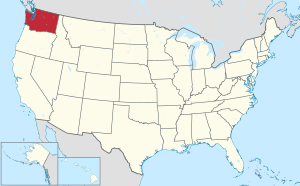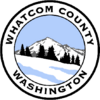
Back مقاطعة واتكوم (واشنطن) Arabic Votkom qraflığı (Vaşinqton) Azerbaijani Whatcom County, Washington BAR Уаткъм Bulgarian হুৱাটকম কাউন্টি, ৱাশিংটন BPY Whatcom Gông (Washington) CDO Уотком (гуо, Вашингтон) CE Whatcom County CEB Whatcom County Czech Whatcom County, Washington Welsh
Whatcom County | |
|---|---|
 Whatcom County Courthouse in Bellingham | |
 Location within the U.S. state of Washington | |
 Washington's location within the U.S. | |
| Coordinates: 48°50′34″N 121°50′11″W / 48.84278°N 121.83639°W | |
| Country | |
| State | |
| Founded | March 9, 1854 |
| Named for | Chief Whatcom |
| Seat | Bellingham |
| Largest city | Bellingham |
| Area | |
| • Total | 2,503 sq mi (6,480 km2) |
| • Land | 2,107 sq mi (5,460 km2) |
| • Water | 397 sq mi (1,030 km2) 16% |
| Population (2020) | |
| • Total | 226,847 |
| • Estimate (2023) | 231,919 |
| • Density | 103/sq mi (40/km2) |
| Time zone | UTC−8 (Pacific) |
| • Summer (DST) | UTC−7 (PDT) |
| Congressional district | 2nd |
| Website | whatcomcounty.us |


Whatcom County (/ˈwɒtkəm/, /ˈhwɒtkəm/) is a county located in the northwestern corner of the U.S. state of Washington, bordered by the Lower Mainland (the Metro Vancouver and Fraser Valley Regional Districts) of British Columbia to the north, Okanogan County to the east, Skagit County to the south, San Juan County across Rosario Strait to the southwest, and the Strait of Georgia to the west. Its county seat and largest population center is the coastal city of Bellingham,[1] comprising the Bellingham, WA Metropolitan Statistical Area, and as of the 2020 census, the county's population was 226,847.[2]
The county was created from Island County by the Washington Territorial Legislature in March 1854. It originally included the territory of present-day San Juan and Skagit counties, which were later independently organized after additional settlement.[3] Its name derives from the Lummi word Xwotʼqom, also spelled [x̣ʷátqʷəm], perhaps meaning 'noisy' or 'noisy water' and referring to a waterfall.[4][5][6] Whatcom County has a diversified economy with a significant agricultural base, including approximately 60% of the nation's annual production of raspberries.[7]
- ^ "Find a County". National Association of Counties. Retrieved June 7, 2011.
- ^ "State & County QuickFacts". United States Census Bureau. Retrieved November 10, 2024.
- ^ "Milestones for Washington State History — Part 2: 1851 to 1900". HistoryLink.org. March 6, 2003.
- ^ Oakley, Janet (July 3, 2005). "Whatcom County — Thumbnail History". HistoryLink. Retrieved November 5, 2024.
- ^ Bright, William (2004). Native American Placenames of the United States. University of Oklahoma Press. p. 564. ISBN 9780806135984. Retrieved January 29, 2023.
- ^ Johnson, Annie (2004). "Shifting Shorelines".
- ^ Bellingham County website https://www.bellingham.org/agricultural December 1, 2021
